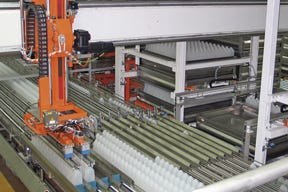Blowmolding: Bottle storage system eases logistics pains
A new automation system could change the traditional method of storing empty containers, especially in processing facilities operating as ‘hole-in-the-wall’ or on-site suppliers to their beverage-filling customers.
November 5, 2009
A new automation system could change the traditional method of storing empty containers, especially in processing facilities operating as ‘hole-in-the-wall’ or on-site suppliers to their beverage-filling customers.
Called Intermediate Bottle Storage System (IBSS) and developed by Autefa automation GmbH (Friedberg, Germany), it could help reduce costs for both the bottle blowmolder and the filler. The IBSS is placed between the blowmolding cell and the filling area, with lanes of a tabletop conveyor running parallel to the system. If bottles need to go directly to the filling lines, they by-pass the IBSS on the conveyors. If bottles are to be placed into interim storage, they are picked and placed by robots and stored in metal trays.
|
While the tray stack is not air tight, the contained bottles are kept in a dust-free environment and ready for downstream processing. A permanently affixed barcode label for system tracking and control identifies each tray. An automatic tray cleaning and sterilization system is also available if required. The total number of trays needed for the system is based on the inventory requirement of the customer that ranges from several hours to several days of storage.
The filled trays are stacked vertically, and then automatically placed into a storage system sized to meet the customer’s inventory requirements. When the bottles are needed for filling or other downstream processing, the stacks of trays are automatically retrieved and unloaded, with bottles placed back onto the tabletop conveyor for delivery to the filling lines.
What a processor won’t need, contrasted with traditional bottle management systems, is dunnage pallets, tier sheets, top frames, stretch wrapping, and/or strapping and labeling. No labor or fork trucks are needed to handle stored bottles. According to Autefa officials, payback for the IBSS runs between two to three years. No direct labor is required to run the system.
A database management system with the IBSS controls the database of stored bottles and trays. Should a bottle quality problem occur, the system can identify, locate, and isolate the particular trays or trays of the suspect bottles. A customized listing of reports can also be generated to highlight inventory levels, identify segregated quality lots, determine available space left in storage, and more.
For smaller operations, a small-scale system can be installed and as the business grows, additional components can be added and integrated into the system. —[email protected]
About the Author(s)
You May Also Like



